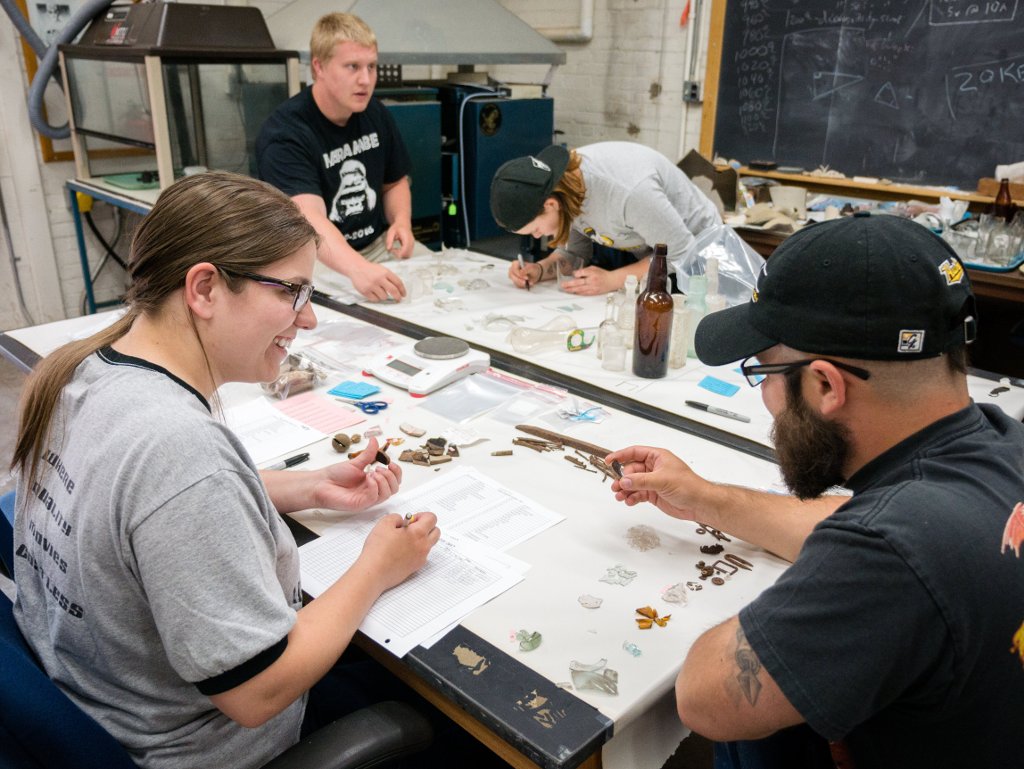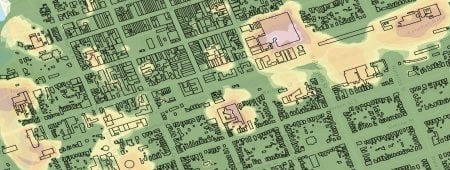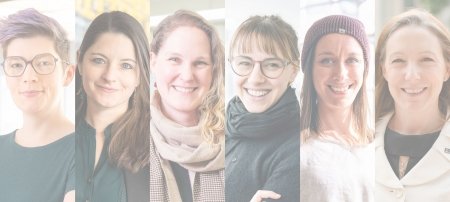Industrial Archaeology students excavate at the Range Light Keepers property in Copper Harbor to better understand the region’s history.
For the 19th-century ship captains who steered vessels into the bustling port of Copper Harbor, avoiding the submerged rocks required elaborate maneuvers, and it became evident that the lighthouse simply wasn’t enough to ensure boats make safe harbor.

To avoid shipwrecks, a private party and later the US government erected two range lights along Fanny Hooe Creek along the shoreline at Fort Wilkins. When the shorter front light was aligned with the taller rear light, ships could enter the harbor safely by following the line of the lights. The range lights are still the twin sentinels that guide ships into the harbor today.
In the 1860s, a range light keeper’s house was built. The rear range light was on the second floor of the home, ensuring that even in a gale the oil-fueled lantern could be lit. Light keepers and their families lived there until the 1930s, when the range lights were electrified and lighting them manually was no longer required.
Though the range light keeper’s home is no longer inhabited, the people who lived there left behind signs of their occupation.
The Remnants of a Structure’s Use
Contrary to those hours spent watching the clock in high school history class, the history of an area and the people who lived there isn’t static. The people who lived in a particular time left behind physical evidence of their lives, much as the people of today will leave behind myriad iPhones, junked cars and a Texas-sized mat of plastic floating in the ocean.
Students in Michigan Technological University’s Industrial Archaeology program spent several weeks this summer excavating the privy and wash house at the range light keeper’s house--an area near the front range light--in search of the Astor house, which historic documents say once housed a printing press, a storehouse and a hotel, as well as the dump across the highway from the house.

The excavation at the Astor house site turned up nails, smoking pipes, a few pieces of ceramic, as well as an earthen berm that may have insulated the rear wall of the structure. Excavations at the lighthouse keepers’ privy and a surface collection at their dump proved fruitful. Outdoor privies doubled as trash dumps prior to curbside pickup. After decades, the primary deposit into the privy has composted into rich, dark soil, but the ceramics, glass bottles, pipe stems and other items remain.
But archaeology is, of course, more than the excavation of stuff—the items found in trash heaps and buried in the ground help researchers create a more accurate picture of the past by weaving together multiple data sources to deepen our understanding of what happened before our own time.
“Archaeology in its most basic definition is the systematic study of the material past,” says James Schwaderer, a PhD student in the Industrial Archaeology program who served as project director for the summer field school. “We do this to help understand and provide greater detail to narratives of the human past.”
Schwaderer said that the project seeks to provide a representative sample of artifacts that can be used to reconstruct the everyday activities associated with the people who lived at or used these sites.
"Oftentimes historic documents can be wrong or leave out certain information depending on who wrote them and why they wrote them. By conducting archaeology we can develop a new narrative or add depth to the current narrative."
Community-engaged Research
The archaeology field school conducted this summer is different from the typical field school model, which focuses on teaching students field techniques in a six-week period. Instead, the focus is on the entire process of archaeological research. Students spent several weeks prior to the dig researching background history of the site, and followed up the excavation researching and cataloguing artifacts uncovered at the site. They will finish the course by writing up the analysis and interpretation of what they have learned about the sites.
LouAnn Wurst, principal investigator of the project and professor of archaeology, says she hopes the field school teaches students to become authorities on a subject. She says that by emphasizing the entire process of archaeology rather than excavation methods, students gain a more complete understanding of the field and learn to collaborate with communities and groups outside the university.

“This is not the abstract classroom but really working with communities and agencies to the mutual benefit of all,” she says.
Wurst and Schwaderer hope to help students understand that the archaeological process is more than finding a piece of glass in the ground—it’s the ability to understand from which time period an artifact came, what values it represents, the status of the person who owned it. Identifying the artifacts is a part of the larger objective of understanding the narrative of a place and the people who lived there.
“I like getting hands-on with history,” Schwaderer says. “It’s a unique way to explore history and the narratives of people that might or may not have been ignored. Historians and archaeologists generally have the same goal: to examine narratives of the past. Historians work with documentary sources; archaeologists are the only group of social scientists that work with the physical remains of the human past. Without archaeology, many tales and narratives, structures, what have you, could be completely lost to history.”

Excavating sites brings one more source of data to a line of research. Historical documents, photos, oral histories, local knowledge, geology, geographic information systems (GIS)—all can be used to pinpoint what happened at a site.
“There’s always a sense of ambiguity in archaeology. We are providing based on evidence recovered our best explanation for what was happening,” Schwaderer says.
"On a broader scope, a lot of time archaeologists are advocates for the preservation of cultural structures on a national and an international level, maintaining the memory of the human past. We are often advocates for those who cannot speak for their own past or their past has been distorted."
It’s Not What You Find, But What You Find Out
Now that the excavation has been completed, the students will spend time in the newly renovated wet and dry lab in the Academic Offices Building Annex cleaning and cataloguing the artifacts.

The artifacts, once the field report is completed, will be transported to the state museum in Lansing. Wurst says part of the reason the state wanted the site excavated is to contribute to the long-term vision for the interpretation and historical reconstruction of the range light site itself.
“It’s not what you find, but what you find out,” Schwaderer says. “In the general public’s view of what archaeology is, too often we’re seen as treasure hunters and not scientists who look for clues to uncover the past and all its nuances. It’s not Indiana Jones. It’s getting rained on, sleeping in a tent, and finding rock after rock with no artifacts in it. It’s hard work but it’s worth it.”
Michigan Technological University is an R1 public research university founded in 1885 in Houghton, and is home to nearly 7,500 students from more than 60 countries around the world. Consistently ranked among the best universities in the country for return on investment, Michigan's flagship technological university offers more than 120 undergraduate and graduate degree programs in science and technology, engineering, computing, forestry, business, health professions, humanities, mathematics, social sciences, and the arts. The rural campus is situated just miles from Lake Superior in Michigan's Upper Peninsula, offering year-round opportunities for outdoor adventure.






Comments